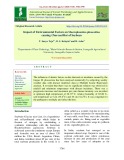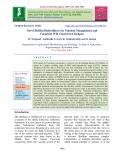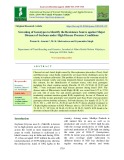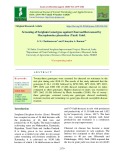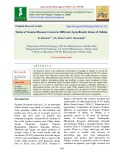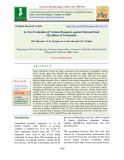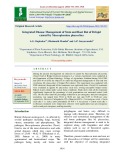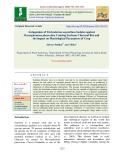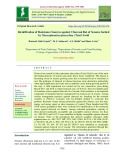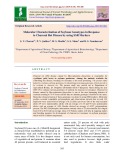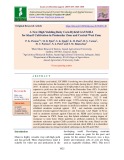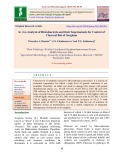
Charcoal rot disease
-
Sesame (Sesamum indicum) charcoal rot, a destructive fungal disease caused by Macrophomina phaseolina (Tassi) Goid (MP), is a great threat to the yield and quality of sesame. However, there is a lack of information about the gene-for-gene relationship between sesame and MP, and the molecular mechanism behind the interaction is not yet clear.
 21p
21p  vijichea2711
vijichea2711
 28-05-2021
28-05-2021
 7
7
 1
1
 Download
Download
-
Soybean (Glycine max L. Merrill) is an important leguminous crop contain huge amount of protein and oil. Among the fungal diseases of soybean, collar rot caused by Sclerotium rolfsii and charcoal rot caused by Corynespora cassiicola are the economically important diseases which attack on root, stem and foliate parts of the plants.
 15p
15p  cothumenhmong11
cothumenhmong11
 11-05-2021
11-05-2021
 10
10
 1
1
 Download
Download
-
The influence of abiotic factors on the charcoal rot incidence caused by the fungus M. phaseolina has been analysed statistically by subjecting weekly weather data with disease incidence data to Multiple Linear Regression analysis. It revealed that there was no significant relation was observed in rainfall and minimum temperature with disease incidence.
 7p
7p  chauchaungayxua10
chauchaungayxua10
 19-03-2021
19-03-2021
 5
5
 1
1
 Download
Download
-
Wilt caused by Fusarium oxysporium f. spciceris is a devastating disease of chickpea. It occurs in 2 stages; seedling stage (0-30%) and reproductive stage (0-57%). Annual chickpea yield loss due to Fusarium wilt was estimated to be 10% in India. So, our objective is to control chickpea wilt disease by using Trichoderma based biofilms as an alternative to chemical fungicides. Trichoderma viride is a potential antagonistic fungi which prevents diseases like wilt, brown rot, damping off, charcoal rot etc.
 7p
7p  trinhthamhodang1215
trinhthamhodang1215
 23-09-2020
23-09-2020
 18
18
 2
2
 Download
Download
-
Charcoal rot and Aerial alight caused by Macrophomina phaseolina (Tassi) Goid and Rhizoctonia solani Kuhn, respectively are major biotic challenges across the country in soybean cultivation. The problem of disease can be overcome nicely by growing resistant variety and using integrated disease management practices. In this concern, for the identification of resistant source, total sixty genotypes including five check varieties namely Shivalik, JS 335, JS 95-60, JS 93-05 and NRC 7 were evaluated under high disease pressure during kharif 2019.
 7p
7p  caygaocaolon6
caygaocaolon6
 30-07-2020
30-07-2020
 11
11
 2
2
 Download
Download
-
Twenty-three genotypes were screened for charcoal rot resistance in the sick plot during rabi 2018-19. The results of the study indicated that the genotypes E 36-1 (12.00) followed by SPH 1903, SPV 2654, SPV 2655, SPV 2656 and CSH 13R (13.00) showed minimum charcoal rot index compared to other genotypes. Highest charcoal rot index was recorded in SPV 2662 (31.00) followed by Phule Anuradha (29.00). Out of twentythree genotypes screened twenty-one genotypes showed moderately resistant reaction and remaining two genotypes showed susceptible disease reaction.
 4p
4p  angicungduoc6
angicungduoc6
 22-07-2020
22-07-2020
 10
10
 1
1
 Download
Download
-
Cowpea (Vigna unguiculata (L.)Walp.) is a poor men’s protein source. It is one of the most ancient human food sources and an important grain legume and hay crop in many tropical and subtropical regions. It is grown in Tamil Nadu and Andhra Pradesh widely as rainfed crop. Cowpea is affected by many diseases caused by viruses, bacteria and fungi. Among the fungal diseases, the charcoal rot caused by Macrophomina phaseolina (Tassi.) Goid causes significant loss in yield. M. phaseolinais a soil borne plant pathogen with a very wide host range.
 12p
12p  chauchaungayxua6
chauchaungayxua6
 26-06-2020
26-06-2020
 10
10
 0
0
 Download
Download
-
An intensive survey was conducted at flowering to ripening of capsule to record the incidence of charcoal rot in ten agroclimatic zones of Odisha during rabi 2014-15. Almost all the fields were infected by more than one disease. The major diseases of sesame recorded were Macrophomina stem and root rot, Cercospora leaf spot, Alternaria blight, powdery mildew, phytopthora blight and phyllody to some extent. Incidence of foliar diseases such as Alternaria blight, Powdery mildew, Cercospora leaf spot ranged from grade 2-4, 0-3 and 1-2 respectively with maximum incidence at Balianta.
 4p
4p  angicungduoc5
angicungduoc5
 14-06-2020
14-06-2020
 7
7
 0
0
 Download
Download
-
Biotic and abiotic stresses are major constraints in the production of groundnut. Among biotic stresses apart from bacterial and viral diseases, many fungal diseases are of economic importance. The major fungal diseases are Early leaf spot (Cercospora arachidicola), Late leaf spot (Cercosporidium personatum), Rust (Puccinia arachidis), Botrytis blight (Botrytis cinera), Aflarot/Yellow mould (Aspergillus flavus), Damping off (Pythium spp.
 7p
7p  nguathienthan5
nguathienthan5
 04-06-2020
04-06-2020
 16
16
 0
0
 Download
Download
-
During the present investigations on charcoal rot caused by Macrophomina phaseolina (Tassi) Goid of Brinjal (Solanum melongena L.), various experiments were conducted at the Department of Plant Pathology, College of Agriculture, Parbhani during 2014-2015 and 2015-16 to fulfill the objective to study the integrated management of stem and root rot disease (M. phaseolina) of brinjal (Pot culture).
 5p
5p  trinhthamhodang1213
trinhthamhodang1213
 02-06-2020
02-06-2020
 10
10
 0
0
 Download
Download
-
Soybean (Glycine max) is a miracle crop due to its extraordinary qualities apart from known for rich source of vegetable protein and oil. Over the years, its production is stagnant or declining owing to climate change and also due to ever changing pathogenic behaviour of Macrophomina phaseolina. The present investigation was undertaken to utilize the dominant resident mycoflora of crop that are capable of adjusting to changing environment apart from its ability to combat the menace of its co-partner (pathogenic group) evolving with them.
 9p
9p  cothumenhmong5
cothumenhmong5
 17-05-2020
17-05-2020
 17
17
 1
1
 Download
Download
-
Seventy-eight genotypes were screened for charcoal rot resistance in the sick plot during rabi 2018-19. The results of the study indicated that the genotypes E 36-1 (11.53 %), followed by DSV 4 (12.24 %), Dagadi Solapur (13.40 %) showed less disease incidence compared to other genotypes. Highest per cent charcoal rot incidence was recorded in CSV 8R (54.34 %). The study also revealed that the local genotypes recorded reduced levels of other charcoal rot parameters such as per cent lodging due to charcoal rot (soft stalk), mean length of spread (MLS) and mean number of nodes crossed (MNC).
 7p
7p  nguaconbaynhay4
nguaconbaynhay4
 22-03-2020
22-03-2020
 11
11
 1
1
 Download
Download
-
Charcoal rot caused by Macrophomina phaseolina (Tassi) Goid is one of the most devastating diseases of sesame and causes heavy losses worldwide. The disease is becoming severe in sesame growing areas due to increased level of inoculum in soil. The pathogen of charcoal rot disease becomes more destructive particularly when high temperature and water stress conditions occur during growing period of the crop.
 7p
7p  chauchaungayxua4
chauchaungayxua4
 18-03-2020
18-03-2020
 6
6
 1
1
 Download
Download
-
Charcoal rot (CR) disease caused by Macrophomina phaseolina is responsible for significant yield losses in soybean production. Among the methods available for controlling this disease, breeding for resistance is the most promising. The present study helped to evaluate soybean genotypes for identifying promising genotypes which proved to be resistant to charcoal rot. The present study was carried out at Department of Agricultural Botany, Dr. Panjabrao Deshmukh Krishi Vidyapeeth, Akola during the year 2018-19 to evaluate various genotypes of soybean for charcoal rot resistance.
 8p
8p  caygaocaolon2
caygaocaolon2
 11-03-2020
11-03-2020
 14
14
 2
2
 Download
Download
-
A new Baby corn hybrid, GAYMH-1 involving two diversified inbred parents was evaluated across the locations all over India during kharif 2015 to kharif 2017. It yielded on an average 14.36 Q/ha baby Corn yield and found 12.6 % superior in yield over the check HM-4 in the Peninsular Zone (PZ). It yielded on an average 22.99 Q/ha baby Corn yield and it is found 18.6 % superior in yield over the check HM-4 in Central West Zone (CWZ). From the quality point of view, this hybrid contains 87.25% moisture, 3.62 % total carbohydrate, 1.82% total soluble sugar, 1.52% reducing sugar, 0.
 6p
6p  caygaocaolon3
caygaocaolon3
 09-03-2020
09-03-2020
 17
17
 1
1
 Download
Download
-
Charcoal rot of sorghum caused by Macrophomina phaseolina is a disease of economic importance for which a high level of genetic resistance is not available. Therefore, an effort was made to manage this disease with potent rhizobacterial strains viz., AUDP 139 and AUDT 801 in CSV 8R and CSV 29R cultivars. In CSV 8R, seed soaked in supernatants of AUDP 139 for two hours recorded least charcoal rot incidence of 40.58 % with highest yield of 1924.90 Kg/ha whereas in CSV 29R, seed treatment with AUDT 801 + AUDP 139 @ 3g/Kg of seeds recorded least disease incidence of 14.
 9p
9p  caygaocaolon3
caygaocaolon3
 27-02-2020
27-02-2020
 15
15
 1
1
 Download
Download
CHỦ ĐỀ BẠN MUỐN TÌM











